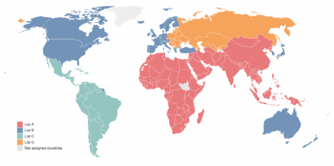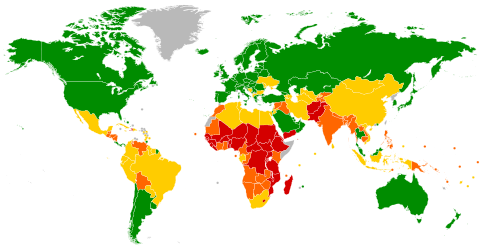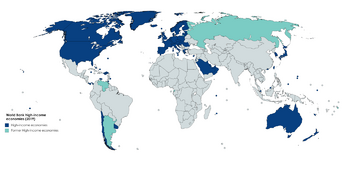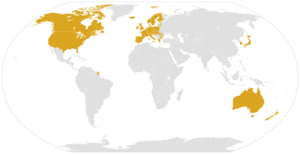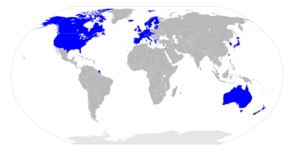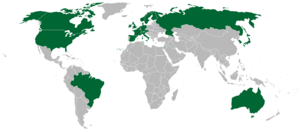Table of Contents
- 1 Definition and criteria
- 2 Economy lists by various criteria
- 3 Comparative table (2023)
- 4 See also
- 5 Notes
- 6 References
- 7 External links Categories
- See also: Developed market
- Digital divide
- First World privilege
- First World problem
- Fourth World
- Globalization
- G8
- G7
- List of countries by wealth per adult
- Multinational corporation
- Western Bloc
- ↑ 1.0 1.1 HDI not available before 2018 in latest report
- ↑ The Developed Countries Glossary entry reads: "The following countries are classified by FTSE as developed countries: Australia, Austria, Belgium/Luxembourg, Canada, Denmark, Finland, France, Germany, Greece, Hong Kong (China), Ireland, Israel, Italy, Japan, Netherlands, New Zealand, Norway, Portugal, Singapore, South Korea, Spain, Sweden, Switzerland, United Kingdom and the United States."
- ↑ Geographically a part of Asia, geopolitically a part of Europe.
- ↑ The HDI annual report compiled by the UNDP does not include Taiwan because it is no longer a UN member state, and is neither included as part of the People's Republic of China by the UNDP when calculating data for China.[39] Taiwan's Statistical Bureau calculated its HDI to be 0.926 based on UNDP's 2010 methodology,[40][41] which would place Taiwan well within the group of "Very high human development" at 19th globally in 2021 within the 2022 UNDP report.[42][43]
- ↑ 1.0 1.1 "World Economic and Financial Surveys World Economic Outlook Database—WEO Groups and Aggregates Information". International Monetary Fund. https://www.imf.org/external/pubs/ft/weo/2022/01/weodata/groups.htm.
- ↑ Least Developed Countries (2018 list )
- ↑ "Fiscal Policy and Inclusive Growth in Advanced Countries: Their Experience and Implications for Asia". Asian Development Bank. December 2014. https://www.adb.org/sites/default/files/publication/150177/ewp-422.pdf.
- ↑ "Advanced Countries Will Benefit Most from Progress in Technology, with Lesser Benefits to Other Nations". RAND Corporation. 1 June 2006. https://www.rand.org/news/press/2006/06/01.html.
- ↑ Developed Economy Definition . Investopedia (16 April 2010). Retrieved 12 July 2013.
- ↑ International Monetary Fund. "World Economic Outlook Database, April 2023". International Monetary Fund. https://www.imf.org/en/Publications/WEO/weo-database/2023/April.
- ↑ (in en) The Courier. Commission of the European Communities. 1994. https://books.google.com/books?id=R2D0AAAAMAAJ. Retrieved 20 January 2021.
- ↑ "Human development index" (in en-GB). Economics Help. https://www.economicshelp.org/blog/glossary/human-development-index/.
- ↑ "Millennium Development Indicators: World and regional groupings". United Nations Statistics Division. 2003. Note b. https://unstats.un.org/unsd/mi/worldmillennium.htm.
- ↑ "Standard Country and Area Codes Classifications (M49): Developed Regions". United Nations Statistics Division. http://unstats.un.org/unsd/methods/m49/m49.htm.
- ↑ "UNCTADstat - Classifications". https://unctadstat.unctad.org/EN/Classifications.html#:~:text=The%20developed%20economies%20broadly%20comprise,as%20Australia%20and%20New%20Zealand.
- ↑ Sachs, Jeffrey (2005). The End of Poverty. New York, New York: The Penguin Press. ISBN 1-59420-045-9. https://archive.org/details/endofpovertyecon0000sach.
- ↑ Wackernagel, Mathis; Beyers, Bert (2019). Ecological Footprint: Managing Our Biocapacity Budget. Gabriola Island, BC, Canada: New Society Publishers. p. 132. ISBN 978-0-86571-911-8. https://www.newsociety.com/Books/E/Ecological-Footprint. Retrieved 20 January 2021.
- ↑ Lee, Eun Su; Liu, Wei; Yang, Jing Yu (23 September 2021). "Neither developed nor emerging: Dual paths for outward FDI and home country innovation in emerged market MNCs" (in en). International Business Review 32 (2): 101925. doi:10.1016/j.ibusrev.2021.101925. ISSN 0969-5931. https://www.sciencedirect.com/science/article/pii/S0969593121001438.
- ↑ 15.0 15.1 15.2 Human Development Report 2021-22: Uncertain Times, Unsettled Lives: Shaping our Future in a Transforming World. United Nations Development Programme. 8 September 2022. pp. 272–276. ISBN 978-9-211-26451-7. https://hdr.undp.org/system/files/documents/global-report-document/hdr2021-22pdf_1.pdf. Retrieved 8 September 2022.
- ↑ 16.0 16.1 Human Development Report 2021-22: Uncertain Times, Unsettled Lives: Shaping our Future in a Transforming World. United Nations Development Programme. 8 September 2022. pp. 277–280. ISBN 978-9-211-26451-7. https://hdr.undp.org/system/files/documents/global-report-document/hdr2021-22pdf_1.pdf. Retrieved 8 September 2022.
- ↑ 17.0 17.1 17.2 CIA (2008). "Appendix B. International Organizations and Groups.". World Factbook.. https://www.cia.gov/library/publications/the-world-factbook/appendix/appendix-b.html.
- ↑ "IMF Advanced Economies List. World Economic Outlook, April 2016, p. 148". http://www.imf.org/external/pubs/ft/weo/2016/01/pdf/text.pdf.
- ↑ World Economic Outlook , International Monetary Fund, September 2011, p. 165.
- ↑ "The Hungarian Quarterly, VOLUME XLI * No. 160 * Winter 2000". http://www.hungarianquarterly.com/no160/104.shtml.
- ↑ "Indian Express". Archived from the original on 27 January 2010. https://web.archive.org/web/20100127184206/http://www.indianexpress.com/old/ie/daily/19971214/34850733.html.
- ↑ Minutes of Forum #26:Global Strategy Series 2 – Japan as It Should Be (Outline) | Economic and Social Research Institute, Cabinet Office, Government of Japan . Esri.go.jp. Retrieved 12 July 2013.
- ↑ https://datahelpdesk.worldbank.org/knowledgebase/articles/906519-world-bank-country-and-lending-groups , World Bank. Accessed on 15 July 2023.
- ↑ 24.0 24.1 24.2 24.3 "World Bank Country and Lending Groups – World Bank Data Help Desk". https://datahelpdesk.worldbank.org/knowledgebase/articles/906519-world-bank-country-and-lending-groups.
- ↑ https://datatopics.worldbank.org/world-development-indicators/the-world-by-income-and-region.html , The World by Income and Region, World Bank. Accessed on 8 July 2021.
- ↑ "Doing Business 2019 Fact Sheet: OECD High-Income". World Bank. http://www.doingbusiness.org/content/dam/doingBusiness/media/Fact-Sheets/DB19/FactSheet_DoingBusiness2019_OECD_Eng.pdf.
- ↑ "Doing Business 2019 Regional Profile: OECD High Income". World Bank. http://www.doingbusiness.org/content/dam/doingBusiness/media/Profiles/Regional/DB2019/OECD-High-Income.pdf.
- ↑ Peer reviews of DAC members – Organisation for Economic Co-operation and Development . Oecd.org. Retrieved 22 October 2013.
- ↑ DAC website >> "The DAC in Dates" , On the DAC's self-description, see the introductory letter. On other events, refer to the relevant section by date.
- ↑ "World Economic and Financial Surveys World Economic Outlook Database—All countries/Advanced economies (40 countries)". International Monetary Fund. https://www.imf.org/en/Publications/WEO/weo-database/2021/October/select-countries?grp=110&sg=All-countries/Advanced-economies.
- ↑ 31.0 31.1 31.2 Human Development Report 2020 The Next Frontier: Human Development and the Anthropocene. United Nations Development Programme. 15 December 2020. pp. 343–346. ISBN 978-9-211-26442-5. http://hdr.undp.org/sites/default/files/hdr2020.pdf. Retrieved 15 December 2020.
- ↑ 32.0 32.1 32.2 "World Economic Outlook Database – Changes to the Database". https://www.imf.org/external/pubs/ft/weo/data/changes.htm.
- ↑ 33.0 33.1 33.2 "World Economic Outlook Database, October 2019". International Monetary Fund. https://www.imf.org/external/pubs/ft/weo/2019/02/weodata/weorept.aspx?pr.x=76&pr.y=12&sy=1980&ey=2024&scsm=1&ssd=1&sort=country&ds=.&br=1&c=512,668,914,672,612,946,614,137,311,546,213,674,911,676,314,548,193,556,122,678,912,181,313,867,419,682,513,684,316,273,913,868,124,921,339,948,638,943,514,686,218,688,963,518,616,728,223,836,516,558,918,138,748,196,618,278,624,692,522,694,622,962,156,142,626,449,628,564,228,565,924,283,233,853,632,288,636,293,634,566,238,964,662,182,960,359,423,453,935,968,128,922,611,714,321,862,243,135,248,716,469,456,253,722,642,942,643,718,939,724,734,576,644,936,819,961,172,813,132,726,646,199,648,733,915,184,134,524,652,361,174,362,328,364,258,732,656,366,654,144,336,146,263,463,268,528,532,923,944,738,176,578,534,537,536,742,429,866,433,369,178,744,436,186,136,925,343,869,158,746,439,926,916,466,664,112,826,111,542,298,967,927,443,846,917,299,544,582,941,474,446,754,666,698&s=PPPPC&grp=0&a=.
- ↑ 34.0 34.1 "World Economic Outlook, October 1989". International Monetary Fund. p. 12. https://www.elibrary.imf.org/doc/IMF081/14573-9781451944433/14573-9781451944433/Other_formats/Source_PDF/14573-9781455235476.pdf.
- ↑ "GDP per capita (current US$) - Liechtenstein". International Monetary Fund. https://data.worldbank.org/indicator/NY.GDP.PCAP.CD?locations=LI&name_desc=false.
- ↑ "Monaco Has The World's Highest Score on the U.N. Human Development Index". Monaco Estate. November 29, 2021. https://monacoestate.com/monaco-has-the-worlds-highest-score-on-the-u-n-human-development-index/.
- ↑ "GDP per capita (current US$) - Monaco". International Monetary Fund. https://data.worldbank.org/indicator/NY.GDP.PCAP.CD?locations=MC.
- ↑ 38.0 38.1 38.2 38.3 International Monetary Fund Annual Report 1997. Annual Report of the Executive Board. International Monetary Fund. October 1997. doi:10.5089/9781451945102.011. ISBN 9781451945102. https://www.elibrary.imf.org/view/IMF011/00315-9781451945102/00315-9781451945102/ch01.xml?language=en. Retrieved 8 May 2020.
- ↑ Nations, United. "Data Reader's Guide" (in en). https://hdr.undp.org/reports-and-publications/2020-human-development-report/data-readers-guide.
- ↑ "What is the human development index (HDI)? How are relevant data queried?". https://eng.stat.gov.tw/public/Data/1513164433IGBKG0IN.pdf.
- ↑ "人類發展指數" (in zh). https://win.dgbas.gov.tw/eyimc/ebook/SB/statistcs-brief_opf_files/pdfs/statistcs-brief__.pdf.
- ↑ "National Statistics, Republic of China (Taiwan) - Statistical Tables". https://eng.stat.gov.tw/ct.asp?xItem=25280&ctNode=6032&mp=5.
- ↑ "國情統計通報" (in zh). https://ws.dgbas.gov.tw/Download.ashx?u=LzAwMS9VcGxvYWQvMC9yZWxmaWxlLzExMDIwLzIyOTU5MS9iNDdhNmYyYy1jNjY2LTRjZDAtYmQ2Ni03OGEyYjMwMmM4MzkucGRm&n=TjExMTEwMTQucGRm&icon=.pdf.
- IMF (advanced economies)
- The World Factbook (developed countries)
- United Nations Statistics Division (definition)
- List of countries, United Nations Statistics Division (developed regions)
- World Bank (high-income economies)
Contents
Developed country
Topic: Finance
 From HandWiki - Reading time: 13 min
From HandWiki - Reading time: 13 min
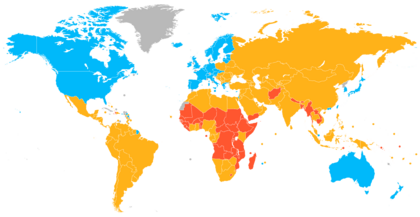
World map showing country classifications per the IMF[1] and the United Nations [2] (last updated April 2023). "Developed economies" according to this classification scheme are shown in blue. The map does not include classifications by the World Bank.
A developed country, or high-income country,[3][4] is a sovereign state that has a high quality of life, developed economy, and advanced technological infrastructure relative to other less industrialized nations. Most commonly, the criteria for evaluating the degree of economic development are the gross domestic product (GDP), gross national product (GNP), the per capita income, level of industrialization, amount of widespread infrastructure and general standard of living.[5] Which criteria are to be used and which countries can be classified as being developed are subjects of debate. Different definitions of developed countries are provided by the International Monetary Fund and the World Bank; moreover, HDI ranking is used to reflect the composite index of life expectancy, education, and income per capita. Another commonly used measure of a developed country is the threshold of GDP (PPP) per capita of at least US$22,000. In 2023, 40 countries fit all four criteria, while an additional 15 countries fit three out of four.
Developed countries have generally more advanced post-industrial economies, meaning the service sector provides more wealth than the industrial sector. They are contrasted with developing countries, which are in the process of industrialisation or are pre-industrial and almost entirely agrarian, some of which might fall into the category of Least Developed Countries. (As of 2023), advanced economies comprise 57.3% of global GDP based on nominal values and 41.1% of global GDP based on purchasing-power parity (PPP) according to the IMF.[6]
Definition and criteria
Economic criteria have tended to dominate discussions. One such criterion is the income per capita; countries with the high gross domestic product (GDP) per capita would thus be described as developed countries. Another economic criterion is industrialisation; countries in which the tertiary and quaternary sectors of industry dominate would thus be described as developed. More recently, another measure, the Human Development Index (HDI), which combines an economic measure, national income, with other measures, indices for life expectancy and education has become prominent. This criterion would define developed countries as those with a very high (HDI) rating. The index, however, does not take into account several factors, such as the net wealth per capita or the relative quality of goods in a country. This situation tends to lower the ranking of some of the most advanced countries, such as the G7 members and others.[7][8]
According to the United Nations Statistics Division:
There is no established convention for the designation of "developed" and "developing" countries or areas in the United Nations system.[9]
And it notes that:
The designations "developed" and "developing" are intended for statistical convenience and do not necessarily express a judgement about the stage reached by a particular country or area in the development process.[10]
Nevertheless, the United Nations Conference on Trade and Development considers that this categorization can continue to be applied:
The developed economies broadly comprise Northern America and Europe, Israel, Japan and the Republic of Korea, as well as Australia and New Zealand.[11]
Similar terms
Terms linked to the concept developed country include "advanced country", "industrialized country", "more developed country" (MDC), "more economically developed country" (MEDC), "Global North country", "first world country", and "post-industrial country". The term industrialized country may be somewhat ambiguous, as industrialisation is an ongoing process that is hard to define. The first industrialized country was the United Kingdom , followed by Belgium. Later it spread further to Germany , United States , France and other Western European countries. According to some economists such as Jeffrey Sachs, however, the current divide between the developed and developing world is largely a phenomenon of the 20th century.[12]
Mathis Wackernagel calls the binary labeling of countries as "neither descriptive nor explanatory. It is merely a thoughtless and destructive endorsement of GDP fetish. In reality, there are not two types of countries, but over 200 countries, all faced with the same laws of nature, yet each with unique features."[13]
A 2021 analysis proposes the term emerged to describe markets, economies, or countries that have graduated from emerging market status, but have not yet reached the level equivalent to developed countries.[14] Multinational corporations from these emerging markets present unique patterns of overseas expansion and knowledge acquisition from foreign countries.
Economy lists by various criteria
Human Development Index (HDI)
The UN HDI is a statistical measure that gauges an economy's level of human development. While there is a strong correlation between having a high HDI score and being a prosperous economy, the UN points out that the HDI accounts for more than income or productivity. Unlike GDP per capita or per capita income, the HDI takes into account how income is turned "into education and health opportunities and therefore into higher levels of human development."
Since 1990, Norway (2001–2006, 2009–2019), Japan (1990–1991 and 1993), Canada (1992 and 1994–2000) and Iceland (2007–2008) have had the highest HDI score.
The following countries ranked from 1 to 66 in the year 2021 are considered to be of "very high human development":[15]
| Rank | Nation/region | HDI | ||
|---|---|---|---|---|
| 2021 data (2022 report)[15] | Change since 2015[16] | 2021 data (2022 report)[15] | Average annual growth (2010–2021)[16] | |
| 0.962 1 | 0
|
0.962 | 0.0019
| |
| 0.961 2 | 0
|
0.961 | 0.0019
| |
| 0.959 3 | 0
|
0.959 | 0.0056
| |
| 0.952 4 | 3
|
0.952 | 0.0044
| |
| 0.951 5 | 3
|
0.951 | 0.0027
| |
| 0.948 6 | 0
|
0.948 | 0.0034
| |
| 0.947 7 | -2
|
0.947 | 0.0036
| |
| 0.945 8 | 6
|
0.945 | 0.0040
| |
| 0.942 9 | -5
|
0.942 | 0.0016
| |
| 0.941 10 | -1
|
0.941 | 0.0024
| |
| 0.940 11 | 0
|
0.940 | 0.0029
| |
| 0.939 12 | -1
|
0.939 | 0.0029
| |
| 0.937 13 | 2
|
0.937 | 0.0025
| |
| -3
|
0.0015
| |||
| 0.936 15 | -2
|
0.936 | 0.0025
| |
| 0.935 16 | -1
|
0.935 | 0.0022
| |
| 0.930 17 | 3
|
0.930 | 0.0018
| |
| 0.929 18 | -3
|
0.929 | 0.0017
| |
| 0.925 19 | 0
|
0.925 | 0.0027
| |
| 3
|
0.0035
| |||
| 0.921 21 | -3
|
0.921 | 0.0010
| |
| 0.919 22 | 0
|
0.919 | 0.0025
| |
| 0.918 23 | 4
|
0.918 | 0.0058
| |
| 1
|
0.0028
| |||
| 0.916 25 | -4
|
0.916 | 0.0014
| |
| 0.911 26 | 9
|
0.911 | 0.0080
| |
| 0.905 27 | 0
|
0.905 | 0.0038
| |
| 0.903 28 | -3
|
0.903 | 0.0027
| |
| 0.896 29 | 3
|
0.896 | 0.0041
| |
| 0.895 30 | -1
|
0.895 | 0.0013
| |
| 0.890 31 | -2
|
0.890 | 0.0030
| |
| 0.889 32 | -6
|
0.889 | 0.0020
| |
| 0.887 33 | -2
|
0.887 | 0.0019
| |
| 0.876 34 | -1
|
0.876 | 0.0037
| |
| 0.875 35 | 3
|
0.875 | 0.0073
| |
| 1
|
0.0035
| |||
| 2
|
0.0064
| |||
| 0.866 38 | 2
|
0.866 | 0.0040
| |
| 0.863 39 | 1
|
0.863 | 0.0042
| |
| 0.858 40 | -6
|
0.858 | 0.0011
| |
| 5
|
0.0040
| |||
| 0.855 42 | 1
|
0.855 | 0.0046
| |
| 1
|
0.0023
| |||
| 0.853 44 | -1000 NA | 0.853 | -1 NA | |
| 0.848 45 | -5
|
0.848 | 0.0009
| |
| 0.846 46 | 1
|
0.846 | 0.0020
| |
| 0.842 47 | -4
|
0.842 | 0.0009
| |
| 0.838 48 | 6
|
0.838 | 0.0103
| |
| 0.832 49 | 3
|
0.832 | 0.0027
| |
| 0.831 50 | -1
|
0.831 | 0.0020
| |
| 0.829 51 | -3
|
0.829 | 0.0001
| |
| 0.822 52 | -2
|
0.822 | 0.0029
| |
| 0.821 53 | -4
|
0.821 | 0.0016
| |
| 0.816 54 | -3
|
0.816 | 0.0032
| |
| 0.812 55 | -2
|
0.812 | 0.0000
| |
| 0.811 56 | 4
|
0.811 | 0.0051
| |
| 0.810 57 | -2
|
0.810 | 0.0023
| |
| 0.809 58 | 4
|
0.809 | 0.0043
| |
| 0
|
0.0025
| |||
| 0.808 60 | -3
|
0.808 | 0.0021
| |
| 0.805 61 | 0
|
0.805 | 0.0037
| |
| 0.803 62 | 1
|
0.803 | 0.0039
| |
| 0.802 63 | 7
|
0.802 | 0.0050
| |
| 2
|
0.0055
| |||
| 4
|
0.0041
| |||
| 0.800 66 | 6
|
0.800 | 0.0075
| |
High-income economies
Some institutions have produced lists of developed countries: the UN (list shown above), the CIA,[17] and some providers of stock market indices (the FTSE Group, MSCI, S&P, Dow Jones, STOXX, etc.). The latter is not included here because its association of developed countries with countries with both high incomes and developed markets is not deemed as directly relevant.[why?][Note 2]
However, many other institutions have created more general lists referred to when discussing developed countries. For example, the International Monetary Fund (IMF) identifies 39 "advanced economies".[18][19] The OECD's 37 members are known as the "developed countries club".[20][21][22] The World Bank identifies 81 "high income countries".[23] Other standards, such as the 30-50 Club (GDP per capita over $30,000 and population over 50 million) have been developed to categorize highly developed and influential countries.
World Bank high-income economies
According to the World Bank the following 83 countries and territories are classified as "high-income economies". As of the 2024 fiscal year, high-income economies are those that had a GNI per capita of $13,845 or more in 2022.[24]
37 countries and territories in Europe:
22 countries and territories in the Americas:
15 countries and territories in Asia:
eight countries and territories in Oceania:
one country in Africa:
eight former high-income economies:[25]
* Between 1994 and 2009, as a part of the ![]() Netherlands Antilles.
Netherlands Antilles.
# Dissolved on 10 October 2010, succeeded by Curaçao and Sint Maarten.
High-income OECD members
According to the World Bank, the following 34 members are classified as "OECD High-Income":[26][27]
26 countries in Europe:
three countries in the Americas:
three countries in Asia:
two countries in Oceania:
Development Assistance Committee members
There are 29 OECD member countries and the European Union—in the Development Assistance Committee (DAC),[28] a group of the world's major donor countries that discusses issues surrounding development aid and poverty reduction in developing countries.[29] The following OECD member countries are DAC members:
23 countries in Europe:
two countries in the Americas:
two countries in Asia:
two countries in Oceania:
IMF advanced economies
According to the International Monetary Fund, 41 countries and territories are officially listed as "advanced economies",[1][30] with the addition of 7 microstates and dependencies modified by the CIA which were omitted from the IMF version:[17]
29 countries and dependencies in Europe classified by the IMF, 6 others given by the CIA:
seven countries and territories in Asia:
three countries and territories in the Americas classified by the IMF, one territory given by the CIA :
two countries in Oceania:
d The CIA has modified an older version of the IMF's list of 38 Advanced Economies, noting that the IMF's Advanced Economies list "would presumably also cover the following nine smaller countries of Andorra, Bermuda, Faroe Islands, Guernsey, Holy See, Jersey, Liechtenstein, Monaco, and San Marino[...]". San Marino (2012) and Andorra (2021) were later included in the IMF's list.[17]
Paris Club members
There are 22 permanent members in the Paris Club (French: Club de Paris), a group of officials from major creditor countries whose role is to find coordinated and sustainable solutions to the payment difficulties experienced by debtor countries.
15 countries in Europe:
three countries in the Americas:
three countries in Asia:
one country in Oceania:
Comparative table (2023)
Comparative table of countries with a "very high" human development (0.800 or higher), according to UNDP; "advanced" economies, according to the IMF; "high income" economies, according to the World Bank; and income per capita (purchasing power parity) higher than $25,000, according to the IMF.
| Developed countries | ||||
|---|---|---|---|---|
| Countries | HDI[31] | IMF[32] | WB[24] | Per capita PPP 2023[33] |
| 2023 | ||||
| Template:Flag2 | Yes since 2007 | Yes since 2023 | Yes since 2017 | Yes since 2016 |
| 2021 | ||||
| Template:Flag2 | Yes since 2021 | Yes since 2012 | Yes since 2000 | Yes before 2004 |
| 2020 | ||||
| Template:Flag2 | Yes since 2003 | Yes since 2020 | Yes since 1990 | Yes before 2010 |
| 2016 | ||||
| Template:Flag2 | Yes since 2005 | Yes since 2014 | Yes since 2012 | Yes since 2016 |
| 2015 | ||||
| Template:Flag2 | Yes since 2005 | Yes since 2015 | Yes since 2012 | Yes since 2013 |
| 2013 | ||||
| Template:Flag2 | Yes since 2001 | Yes since 1989[34] | Yes since 1996 | Yes since 2013 |
| 2012 | ||||
| Template:Flag2 | Yes since 2003 | Yes since 2011 | Yes since 2006 | Yes since 2012 |
| 2011 | ||||
| Template:Flag2 | Yes since 2006 | Yes since 2009 | Yes since 2007 | Yes since 2011 |
| 2009 | ||||
| Template:Flag2 | Yes since 2001 | Yes since 2009 | Yes since 2006 | Yes since 2006 |
| 2008 | ||||
| Template:Flag2 | Yes since 2003 | Yes since 2008 | Yes since 2002 | Yes since 2007 |
| Template:Flag2 | Yes since 2000 | Yes since 2008 | Yes since 1990 | Yes since 1987[35] |
| Template:Flag2 | Yes before 1990[36] | Yes since 2008 | Yes before 1990 | Yes since 1987[37] |
| 2007 | ||||
| Template:Flag2 | Yes since 1998 | Yes since 2007 | Yes since 1997 | Yes since 2006 |
| Template:Flag2 | Yes since 2005 | Yes since 1989[34] | Yes since 1994 | Yes since 2007 |
| 2006 | ||||
| Template:Flag2 | Yes since 1991 | Yes since 1997[38] | Yes since 1987 | Yes since 2006 |
| Template:Flag2 | Yes since 1999 | Yes since 1997[38] | Yes since 2001 | Yes since 2006 |
| 2003 | ||||
| Template:Flag2 | Yes before 1990 | Yes since 1945 | Yes since 1987 | Yes since 2003 |
| 2002 | ||||
| Template:Flag2 | Yes since 2001 | Yes since 2001 | Yes since 1988 | Yes since 2002 |
| Template:Flag2 | N/A[Note 4] | Yes since 1997[38] | Yes since 1987 | Yes since 2002 |
| 2001 | ||||
| Template:Flag2 | Yes since 1995 | Yes since 1945 | Yes since 1987 | Yes since 2001 |
| 1999 | ||||
| Template:Flag2 | Yes since 1999 | Yes since 1997[38] | Yes since 1987 | Yes since 1991 |
| Template:Flag2 | Yes since 1994 | Yes since 1945 | Yes since 1987 | Yes since 1999 |
| Template:Flag2 | Yes since 1992 | Yes since 1945 | Yes since 1987 | Yes since 1999 |
| 1998 | ||||
| Template:Flag2 | Yes since 1996 | Yes since 1945 | Yes since 1987 | Yes since 1998 |
| Template:Flag2 | Yes before 1990 | Yes since 1945 | Yes since 1987 | Yes since 1998 |
| Template:Flag2 | Yes before 1990 | Yes since 1945 | Yes since 1987 | Yes since 1998 |
| Template:Flag2 | Yes since 1993 | Yes since 1945 | Yes since 1987 | Yes since 1998 |
| 1997 | ||||
| Template:Flag2 | Yes before 1990 | Yes since 1945 | Yes since 1987 | Yes since 1997 |
| Template:Flag2 | Yes before 1990 | Yes since 1945 | Yes since 1987 | Yes since 1997 |
| Template:Flag2 | Yes before 1990 | Yes since 1945 | Yes since 1987 | Yes since 1997 |
| 1996 | ||||
| Template:Flag2 | Yes since 1995 | Yes since 1945 | Yes since 1987 | Yes since 1996 |
| Template:Flag2 | Yes since 1992 | Yes since 1945 | Yes since 1987 | Yes since 1996 |
| Template:Flag2 | Yes before 1990 | Yes since 1945 | Yes since 1987 | Yes since 1996 |
| Template:Flag2 | Yes before 1990 | Yes since 1945 | Yes since 1987 | Yes since 1996 |
| 1995 | ||||
| Template:Flag2 | Yes before 1990 | Yes since 1945 | Yes since 1987 | Yes since 1995 |
| 1994 | ||||
| Template:Flag2 | Yes since 1991 | Yes since 1945 | Yes since 1987 | Yes since 1994 |
| 1992 | ||||
| Template:Flag2 | Yes since 1992 | Yes since 1945 | Yes since 1987 | Yes since 1986 |
| Template:Flag2 | Yes before 1990 | Yes since 1945 | Yes since 1987 | Yes since 1992 |
| 1988 | ||||
| Template:Flag2 | Yes before 1990 | Yes since 1945 | Yes since 1987 | Yes since 1988 |
| 1987 | ||||
| Template:Flag2 | Yes before 1990 | Yes since 1945 | Yes since 1987 | Yes since 1986 |
| In process | ||||
| Countries | HDI[31] | IMF[32] | WB[24] | per capita PPP 2023[33] |
| Yes since 2014 | No | Yes since 2012 | Yes since 2022 | |
| Template:Flag2 | Yes since 2007 | No | Yes since 2012 | Yes since 2021 |
| Template:Flag2 | Yes since 2021 | No | Yes since 2006 | Yes since 2006 |
| Template:Flag2 | Yes since 2013 | No | Yes since 2021 | Yes since 2017 |
| Yes since 2019 | No | Yes since 2021 | Yes since 2015 | |
| Template:Flag2 | Yes since 2016 | No | Yes since 1987 | Yes since 1999 |
| Template:Flag2 | Yes since 2005 | No | Yes since 2014 | Yes since 2014 |
| Template:Flag2 | Yes since 2003 | No | Yes since 2009 | Yes since 2014 |
| Template:Flag2 | Yes since 2014 | No | Yes since 1987 | Yes since 1992 |
| Template:Flag2 | Yes since 2012 | No | Yes since 2001 | Yes since 1983 |
| Template:Flag2 | Yes since 2012 | No | Yes since 2007 | Yes since 1990 |
| Template:Flag2 | Yes since 2010 | No | Yes since 2004 | Yes before 1980 |
| Template:Flag2 | Yes since 2004 | No | Yes since 1987 | Yes before 1980 |
| Template:Flag2 | Yes since 1999 | No | Yes since 1990 | Yes before 1985 |
| Template:Flag2 | Yes since 1996 | No | Yes since 1987 | Yes before 1980 |
| Other recognitions | ||||
| Countries | HDI[31] | IMF[32] | WB[24] | per capita PPP 2023[33] |
| Template:Flag2 | Yes since 2019 | No | No | Yes since 2023 |
| Template:Flag2 | Yes since 2019 | No | No | Yes since 2022 |
| Yes since 2019 | No | No | Yes since 2022 | |
| Template:Flag2 | Yes since 2006 | No | No | Yes since 2022 |
| Template:Flag2 | Yes since 2013 | No | No | Yes since 2022 |
| Template:Flag2 | Yes since 2015 | No | No | Yes since 2021 |
| Template:Flag2 | Yes since 2015 | No | No | Yes since 2018 |
| Template:Flag2 | Yes since 2016 | No | No | Yes since 2017 |
| Template:Flag2 | No | No | Yes since 2012 | Yes since 2017 |
| Template:Flag2 | Yes since 2013 | No | No | Yes since 2017 |
| Template:Flag2 | No | No | Yes since 2014 | Yes since 2016 |
| Template:Flag2 | Yes since 2015 | No | No | Yes since 2015 |
| Template:Flag2 | No | No | Yes since 2006 | No |
| No | No | No | Yes since 2023 | |
| No | No | Yes since 2022 | Yes since 2022 | |
| Yes since 2021 | No | No | No | |
| No | No | No | Yes since 2021 | |
| Template:Flag2 | Yes since 2019 | No | No | No |
| Template:Flag2 | No data | No | Yes since 2019 | No |
| Template:Flag2 | No | No | Yes since 2012 | Yes since 2023 |
| Template:Flag2 | Yes since 2012 | No | No | No |
See also
Notes
References
External links
 | 0.00      (0 votes) (0 votes) |
 KSF
KSF
